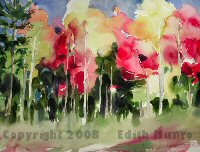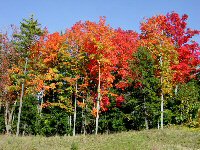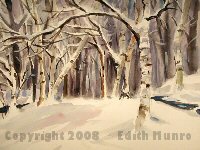Art Lessons

Lesson 3 - Working from Photographs

I think that this photograph would make a great painting !
Not all of us have the luxury of an unlimited time to paint "plein air", especially in the places and moments that we desire to capture. If life were different, we should all be millionaires and have endless resources and time. We'd never have to paint from photos again !
The next best thing is to work from photos, but perhaps we should try not to rely upon them too vigorously. Working from a good photo is not a sin, and even working from a bad one can be interesting, as long as it is used as a departure point alone, and creatively massaged by the artist into a great painting.
Ideally, the photograph should arise from your own individual experience. If you have chosen to capture a moment on film, it is yours to keep. Use your photo as an inspiration, as an assistant, as a reference. Use your photo for its composition, or its color scheme or a mood. A photo captures a moment and suspends time, and you can revisit that moment in time at your own convenience.
This being said, paint only from your own photos. Don't copy; don't plagiarize someone else's work. If a friend has a picture that you would like to use, ask permission. Ideally, a kernel of an idea for a photo or a painting should arise from your own individual experience. Learn to take good photos. I highly recommend digital photography for its immediacy, its capacity for manipulation and sharing, not to mention the fact that it conserves a few trees.
Be aware that photographs do simplify our lives by delivering the composition in two dimensions, which makes it easier for our eyes to see and our brains to transfer the composition to our watercolor paper. It is no longer necessary to interpret the three dimensional scene. Avoid tracing, however, and try to envision the scene that the photograph represents, in depth and time.
Photographs simplify color and value, but at the same time they tend to deaden them as well. The eye and brain can see a million colors at the same time, but a 4 x 6 print is a composite of perhaps three inks that mimic what our eye can see, and certainly do a good job, but pigment is no match for light.
I do recommend working outdoors or from still life whenever possible. Get out of the house, take your paints or pencils outside and set up your easel in your yard, or if it is cold, pack them in your car and try to paint next to your steering wheel. I have found that if I push back my passenger seat I can prop up my paper on the dashboard and my palette in the driver's seat. The point is to get out and to learn to see in three dimensions. It is harder than in two. Working outdoors forces you to paint more quickly and deliberately to capture the light. It changes so quickly. Capturing a scene on paper with watercolor can be difficult, but it gets easier with practice.
Finally, go out and paint because you will feel how cold it is, or you will feel how beautiful the day is, or how the lilacs smell or how your coffee tastes. You will be experiencing all kinds of feelings while you are painting. Those feelings will come out in your brushwork, but will never come home in a photograph.
Here are a few examples of working from photographs...
Not all of us have the luxury of an unlimited time to paint "plein air", especially in the places and moments that we desire to capture. If life were different, we should all be millionaires and have endless resources and time. We'd never have to paint from photos again !
The next best thing is to work from photos, but perhaps we should try not to rely upon them too vigorously. Working from a good photo is not a sin, and even working from a bad one can be interesting, as long as it is used as a departure point alone, and creatively massaged by the artist into a great painting.
Ideally, the photograph should arise from your own individual experience. If you have chosen to capture a moment on film, it is yours to keep. Use your photo as an inspiration, as an assistant, as a reference. Use your photo for its composition, or its color scheme or a mood. A photo captures a moment and suspends time, and you can revisit that moment in time at your own convenience.
This being said, paint only from your own photos. Don't copy; don't plagiarize someone else's work. If a friend has a picture that you would like to use, ask permission. Ideally, a kernel of an idea for a photo or a painting should arise from your own individual experience. Learn to take good photos. I highly recommend digital photography for its immediacy, its capacity for manipulation and sharing, not to mention the fact that it conserves a few trees.
Be aware that photographs do simplify our lives by delivering the composition in two dimensions, which makes it easier for our eyes to see and our brains to transfer the composition to our watercolor paper. It is no longer necessary to interpret the three dimensional scene. Avoid tracing, however, and try to envision the scene that the photograph represents, in depth and time.
Photographs simplify color and value, but at the same time they tend to deaden them as well. The eye and brain can see a million colors at the same time, but a 4 x 6 print is a composite of perhaps three inks that mimic what our eye can see, and certainly do a good job, but pigment is no match for light.
I do recommend working outdoors or from still life whenever possible. Get out of the house, take your paints or pencils outside and set up your easel in your yard, or if it is cold, pack them in your car and try to paint next to your steering wheel. I have found that if I push back my passenger seat I can prop up my paper on the dashboard and my palette in the driver's seat. The point is to get out and to learn to see in three dimensions. It is harder than in two. Working outdoors forces you to paint more quickly and deliberately to capture the light. It changes so quickly. Capturing a scene on paper with watercolor can be difficult, but it gets easier with practice.
Finally, go out and paint because you will feel how cold it is, or you will feel how beautiful the day is, or how the lilacs smell or how your coffee tastes. You will be experiencing all kinds of feelings while you are painting. Those feelings will come out in your brushwork, but will never come home in a photograph.
Here are a few examples of working from photographs...
Snowy Birches
I relied on this photo fairly heavily, however I chose to add more subtle color, since the photo was overly blue due to the fact that it was overcast. I painted in all of the spaces between the trees first.
I relied on this photo fairly heavily, however I chose to add more subtle color, since the photo was overly blue due to the fact that it was overcast. I painted in all of the spaces between the trees first.
Assorted Colors
This photo inspired me despite the fact that it was taken from a parking lot. I went crazy with pure color using maskoid to preserve the trunks.
This photo inspired me despite the fact that it was taken from a parking lot. I went crazy with pure color using maskoid to preserve the trunks.
Early Snow
In this work I painted the entire background first - the negative space. I accented the edges around the leaves with my favorite filbert brush. Then I slowly worked in the leaves, being careful to preserve the pure whites of the paper.
In this work I painted the entire background first - the negative space. I accented the edges around the leaves with my favorite filbert brush. Then I slowly worked in the leaves, being careful to preserve the pure whites of the paper.






